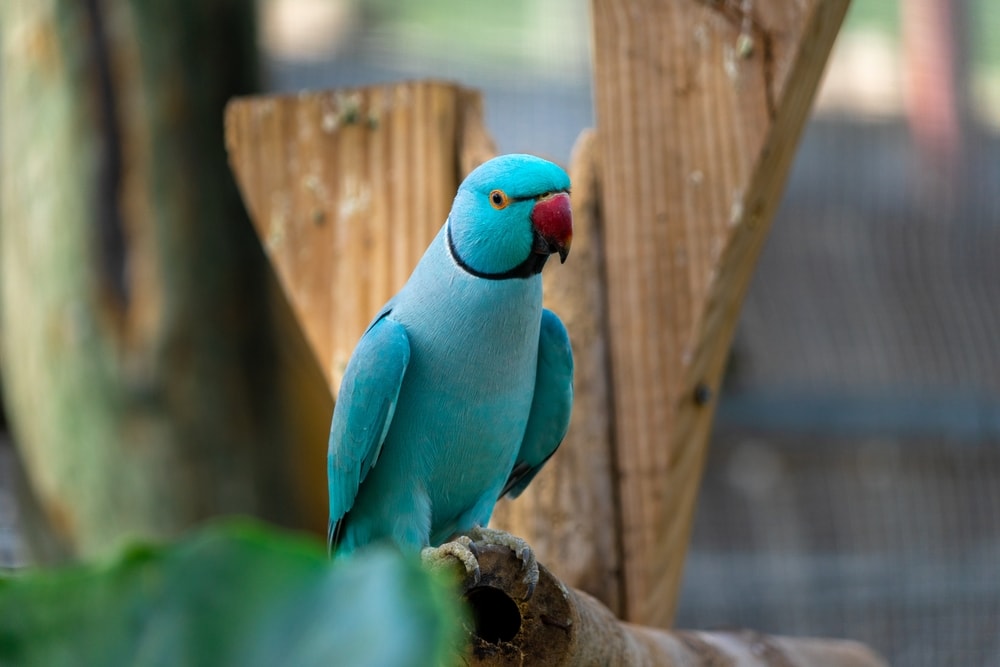
Pet birds come in all shapes, colors, and sizes. Adored by bird enthusiasts all over the world, the blue parakeet (Melopsittacus undulatus) is a friendly and sociable bird with a unique and striking blue appearance, all packed in a tiny body!
Blue parakeets have captured the hearts of bird lovers for decades. If you’re considering adopting a blue parakeet, it is crucial to do your research on the care requirements for this pet. As a color variation of the parakeet, there is so much to explore about this beautiful blue bird! Blue parakeets are not a specific species but rather a color variation, so they will need the same care as a Melopsittacus undulatus of any color!
Note: “A parakeet isn’t a specific type of parrot, but rather a term given to several small to medium-sized species of parrots with long tail feathers. The term parakeet isn’t a taxonomical reference to any genus or family of parrots; the parrots, sometimes referred to as parakeets, span multiple genera. Examples of parrots generally termed parakeets include budgies, cockatiels, ring-necked parrots, and Alexandrine parrots.”
Species Overview
Color:
Blue with black and white accents
Size:
6–7 inches (15–18 cm)
Weight:
1.1–1.4 ounces (30–40 grams)
Wingspan:
11–13 inches (28–33 centimeters)
These small parakeets are native to Australia, where they inhabit a diverse range of environments, from open grasslands to arid deserts. Their nomadic nature and ability to adapt to varying conditions have contributed to their resilience as a species and their allure as pets.
But the fascination with blue parakeets goes beyond their appearance. These birds are celebrated and loved for their social and intelligent nature. They readily form deep bonds with their human companions, displaying affection and curiosity. Their ability to mimic sounds, including speech, has made them entertaining and beloved companions through the years.
Blue Parakeet Characteristics
The Earliest Records of Blue Parakeets in History
Parakeets have been part of the Australian ecosystem for millions of years, but the budgerigar was first scientifically described in 1805 by English zoologist Dr. George Kearsly Shaw, according to Australian Geographic.1
In the wild, these birds are found in a variety of habitats, ranging from open grasslands to arid deserts. They are known for their nomadic nature, often moving in search of food and water. Their ability to adapt to diverse environments is a testament to their resilience as a species, which has contributed to their popularity as pets.
Image credit: UniqSnaps, Shutterstock
How Blue Parakeets Gained Popularity
In the mid-1800s, these birds were highly craved because of their vibrant colors and have since become one of the most commonly kept pet bird species worldwide. In fact, the Melopsittacus undulatus is the most popular pet bird and has been for decades.
Unfortunately, back then, the birds were not always kept as pets to admire. Their feathers were used as “fashion”, so thousands of parakeets were plucked or stuffed, equaling almost 680 tons of feathers sold in London’s Mincing Lane auction houses annually.
Because of this, the Australian branch of the Society for the Protection of Birds made pleas about the welfare of the parakeet and that the use of feathers at this rate will lead to the decline of this species and other bird species.
Formal Recognition of Blue Parakeets
There are no formal societies that recognize bird species as there are for cats and dogs.
However, to protect endangered birds and reduce illegal trade, there is a list of bird species that can be kept as pets as defined by the Animal Welfare Regulation.2
Image Credit: UniqSnaps, Shutterstock
3 Little-Known Facts About the Blue Parakeet
1. They Are Prolific Breeders
Blue parakeets have a well-deserved reputation as prolific breeders. In the wild, these birds have adapted to unpredictable environmental conditions by rapidly reproducing. When kept as pets, blue parakeets are known to have an average clutch size of 4 to 6 eggs, and they can produce multiple clutches per year. Their nesting and breeding behavior is a testament to their remarkable reproductive adaptability.
However, it’s crucial for responsible breeders and pet owners to manage their breeding pairs to ensure the health and well-being of the birds, as constant breeding can deplete their resources and impact their overall health.
2. They Can Speak Up to 100 Words
One of the most endearing and fascinating traits of blue parakeets is their capacity for speech and mimicry. Although not as clear as other parrot species, these small parrots are surprisingly skilled vocalists, capable of learning and repeating words and phrases.
While individual abilities can vary, some blue parakeets have been known to acquire vocabularies of up to 100 words or more. They can mimic not only human speech but also a variety of sounds and noises from their environment. This talent for vocalization, coupled with their social and intelligent nature, makes them a popular choice for those seeking a talkative and engaging pet bird.
3. They Can See in the Ultraviolet Spectrum
One of the little-known but remarkable features of blue parakeets is their ability to see in the ultraviolet (UV) spectrum. Unlike humans, who are limited to a narrow range of visible colors, these birds possess specialized photoreceptor cells in their eyes that allow them to perceive a broader spectrum, including UV light.
This unique visual capability has significant implications in their daily lives, aiding them in tasks such as foraging for food, identifying potential mates, and recognizing patterns on plumage. It’s a stunning example of their evolutionary adaptations, as it provides them with a richer perception of their surroundings, allowing them to excel in various aspects of their natural behavior.
Image Credit: OlhaTsiplyar, Shutterstock
Does the Blue Parakeet Make a Good Pet?
While they are considered easy to care for and are perfect for novice bird owners, caring for a blue parakeet still involves several key considerations. Ensuring proper nutrition is crucial for their well-being. Additionally, providing an appropriately sized cage with various perches and stimulating toys is essential.
Blue parakeets are active birds, and they need an environment that allows them to exercise and engage their agile bodies. Regular interaction and mental stimulation are equally important for maintaining their happiness and health, as they are highly social creatures that thrive on companionship.
Although blue parakeets have a shorter-than-average lifespan of 7–10 years, they are generally considered healthy birds. Regardless, it is important to understand that they can be susceptible to specific health issues, including Parrot fever, Polyoma virus, and even Psittacine Beak and Feather Disease (PBFD).
Regular check-ups by a qualified avian veterinarian are crucial to ensure their health. Maintaining proper hygiene in their living environment, providing a balanced diet, and monitoring for signs of illness are essential aspects of responsible ownership.
Being proactive in addressing any health concerns promptly can significantly increase the lifespan and quality of life of your blue parakeet.
Conclusion
The blue parakeet, with its rich history, temperament, vocalizations, and unique appearance, has rightfully earned its place as one of the most popular and beloved pet birds in the world.
Providing proper care and attention to their diet, housing, exercise, and health needs is crucial for ensuring their well-being and happiness as cherished companions. As we continue to uncover the hidden facets of these remarkable birds, we appreciate the unique qualities that make them a delightful and rewarding addition to our lives as pet owners!
Featured Image Credit: pets in frames, Shutterstock






